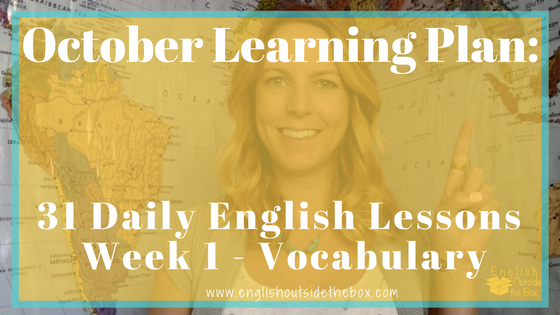
October Learning Plan: 31 Daily English Lessons – Week 1 Vocabulary
Hello October and hello new month of learning! I am over the moon (*so excited*) to be sharing a very special learning plan with you today, which I’ve created to give you 31 daily lessons to improve your English skills. Today kicks off (*starts*) the 4-week series, called your October Learning Plan. I’ve gotten together with other teachers and English bloggers to give you even more learning opportunities, various resources and exercises to help you improve your skills.
We’re going to break up (*divide*) this learning plan into 4 weeks. This week we are working to improve English vocabulary fluency, so not only will you increase your vocabulary knowledge, we’ll review ways to learn, remember, and continue improving vocabulary fluency even after the week and month come to an end!
You can get a quick review of the full month’s plan here, and continue reading this full English lesson for your 5 Minute English video and more explanation for this week’s lessons and activities.
As I mentioned, this week will help you improve English vocabulary fluency. Every day you have a new task, a different resource, and an opportunity to take your skills to the next level. Now is not the time to be lazy, if you work hard you will notice improvement in your skills as we get to the end of the month. The key is dedication. Are you ready to begin?
Let’s begin with the audio portion of today’s lesson and this week’s learning plan. You can use this video to practice note-taking skills as well, by writing down what you hear. When you finish, continue reading for more details, the links and to fill in any missing information in your notes.
Good luck!
Week 1: Vocabulary Fluency
Vocabulary [noun]: all of the words known by a person
How confident are you with your vocabulary knowledge? By the end of the week, I am sure you will be feeling much better.
Day 1: October 4
Using your surroundings to increase your vocabulary: Name those objects!
Are you able to confidently talk about the everyday objects that surround you? Sometimes students focus on “academic” vocabulary, or want to learn phrasal verbs, idioms, etc.. and forget about the simple language. They find it difficult to name that strange thing sitting on their desk, or the tools they always use in their kitchen. However, these are important! So today you’ll work on these common objects.
Choose any room or place in your house (or around you) and write down as many objects as you can. Are there words you don’t know? Take a picture and upload them on Facebook to ask me or others (you can find my Facebook here). You can do this by theme, for example: words in the kitchen, words in the fridge (food items), etc.. You saw an example in the video, but right now at my desk, for example, I see: a mouse, computer screen, keyboard, window, Post-it notes, computer charger, printer….
If you want to add an extra challenge, try and write the words in a sentence with a verb. For example: I type on my keyboard. My computer charger charges my battery.
Day 2: October 5
Learn words with multiple meanings every day on English Outside the Box’s Instagram
If you type the word “get” into Merriam Webster Learner’s Dictionary, you’ll see well over 50+ meanings for this word. This is true for many, many English words. Some words have multiple meanings and multiple parts of speech [noun, verb, adjective, etc…], so it can be confusing trying to learn these. This week on Instagram, I will teach you a new word with a multiple meaning every single day. Today you’ve already learned jam [from the video], so it’s time to get over to Instagram and see what I am teaching for Day 2!
In order to practice, you’ll need to use the words and their meanings in a variety of sentences. Try making your own examples. You can write these examples in your notebook, or for feedback, in the comments below this blog or the Instagram picture.
Day 3: October 6
English for Study: 14 Ways to Learn more Vocabulary
(click the title above [in yellow] to read the full lesson)
Connect with Sam today from English For Study! Sam’s tip for this lesson:
“In this article, you’ll learn 14 of the best ways to learn new vocabulary. You might know some of them, but others will probably be new to you, such as strategies 6, 10 and 14! Give them a try!”
I recommend trying to use at least 3 of these new strategies today. Let us know what you used and what you loved!
Day 4: October 7
New York Times: What’s Going on in this Picture?
(click the title above [in yellow] to read the full lesson)
Using images is one of my favorite to teach English, because imagination and creativity can take the lesson and learning possibilities in so many directions. The New York Times has this weekly feature for English learners (or lovers) to have discussions, and you can use it to increase your vocabulary. Practice describing the picture, what do you see? who do you see? what are they wearing? what can you infer (*guess from evidence*) about where they are or the season it is (summer, winter, etc..)?
If you are a basic or low-intermediate English student, it’s okay to just name objects, nouns, adjectives, and single words you see. More advanced speakers should try and create complete sentences. The video gives you a picture example with a man and a chimpanzee. You can name the colors you see (yellow, blue), objects (helmet, wires, cables), etc..
Day 5: October 8
Synonym Building: Turning 1 Dollar Words (easy/boring words) into 100 Dollar Words
It’s common to get into “word habits” and always use the same words to describe things. Perhaps the most common habit would be when we answer the question, “how are you?” How often do you say, “I’m good,” or “I’m fine.” ? Good and fine do describe your mood, and will get your point across; however, they are so boring!
Today we’ll use a thesaurus to make some common boring words a bit more exciting and more advanced! I’ll give you a few words to try in this lesson, but I recommend doing this for other words you know you overuse (*use too much*).
You need to start by downloading a thesaurus app on your phone (I recommend one in this article, My Top Apps for Learning), or you can visit www.thesaurus.com. Next, choose your word! We’ll start with very [adverb] to a great degree.
Step 1: type the word into the search bar
Step 2: make sure you choose the word with the same meaning as you want to use
Step 3: click on sort by relevance to find the words most closely related
Step 4: learn and start using these new words!
Now instead of saying, “I am very tired,” you can say, “I am incredibly tired,” or “I am extraordinarily tired.”
As a bonus, you can also use the thesaurus to learn antonyms (words that mean the opposite) to add to your vocabulary knowledge.
Other words to try today:
- say (specifically, “said”) – as in the word for reported speech. “I said I was happy.” “I said no” etc..
- Instead, you can use: stated, added, answered/responded/replied (if answering/responding to a question), mentioned, yelled, declared, announced, etc…
- I stated that I was tired. I added that I was going to join them. I yelled no!
- Instead, you can use: stated, added, answered/responded/replied (if answering/responding to a question), mentioned, yelled, declared, announced, etc…
- sometimes – [adverb] occasionally
- Instead, you can use: from time to time, every now and then, every so often, at times, etc…
- I go for a run from time to time. Every now and then I go to bed early. I study French every so often.
- Instead, you can use: from time to time, every now and then, every so often, at times, etc…
Day 6: October 9
English with Kim: Collocations with Do and Sports Activities
(click the title above [in yellow] to read the full lesson)
Connect with Kim today from English with Kim. Kim’s tip for this lesson:
Day 7: October 10
American VS Australian Vocabulary Differences
Even though Australians and Americans use English, did you know there are many words that are really different? Take this example for instance. What does a “bloke” and a “sheila” mean? They are definitely not used in American English, but what if you travel down under to Australia and hear these words?
https://www.instagram.com/p/rpZ8d4xLRH/?taken-by=jenesl760
Here is a quick infographic [image] for you to review some of the differences between American English and Australian English. You can review the full infographic, more vocabulary examples, a video with some Australians, and some tips on “how to speak like an Australian” in this full English lesson here, “Travel with Me, Part 3: Australia”.
(click the full lesson title to get the full lesson)
Don’t forget what you learn in today’s lesson! So make sure you write some sentences, tell a friend about some of the differences, or use the new Australian language with a friend or colleague in English. Practice makes perfect!
Wow! What a week!
You have so much that you can do to start improving your skills, so I will let you start practicing. If you have any questions or comments, please let me know in the comment section below. Feel free to write some of your practice sentences, too!
About the Guest Authors:

Sam is an English language coach who specialises in English for university and helping you become an independent learner. He is a lecturer in English for Academic Purposes and is the founder of the site, English For Study. You can sign up to his free email masterclass The Five Reasons You’re Not Improving here

Kim is an online English teacher whose goal is to help you sound more natural in English. She offers tips on improving your conversation skills and fine-tuning your English at englishwithkim.com.
Did you enjoy this week’s October Learning Plan activities and lessons? Please share this lesson with a friend or a colleague!
Don’t forget to come back for next week, week 2!
Happy Studying ♥
P.S…
I know this learning plan started on October 4, and I promised you 31 daily lessons! So it’s time to catch up with the first 3 days of learning. Here are a few recommendations of activities you can complete! Choose 3 and add them to your routine to get 31 lessons!
- Use Merriam Webster Learner’s Dictionary app to get the “word of the day”. Write your own sentences to practice the new word!
- Visit newsinlevels.com, take the reading level test, and then choose some articles to read that match your level. Each article has new vocabulary!
- Use the search bar on my blog to find and review past English lessons. There are tons of articles on pronunciation, grammar, idioms, and more. Type a topic you want to learn and enjoy!
- Visit YouTube and search for Rachel’s English, she’s the queen of American English pronunciation. Watch her videos and improve your pronunciation today!
- Write down 5 things you want to learn in English. Then brainstorm (think) about ways you can learn them. If you don’t know, then ask me! Comment below with your weakness(es) and I’ll try to help!

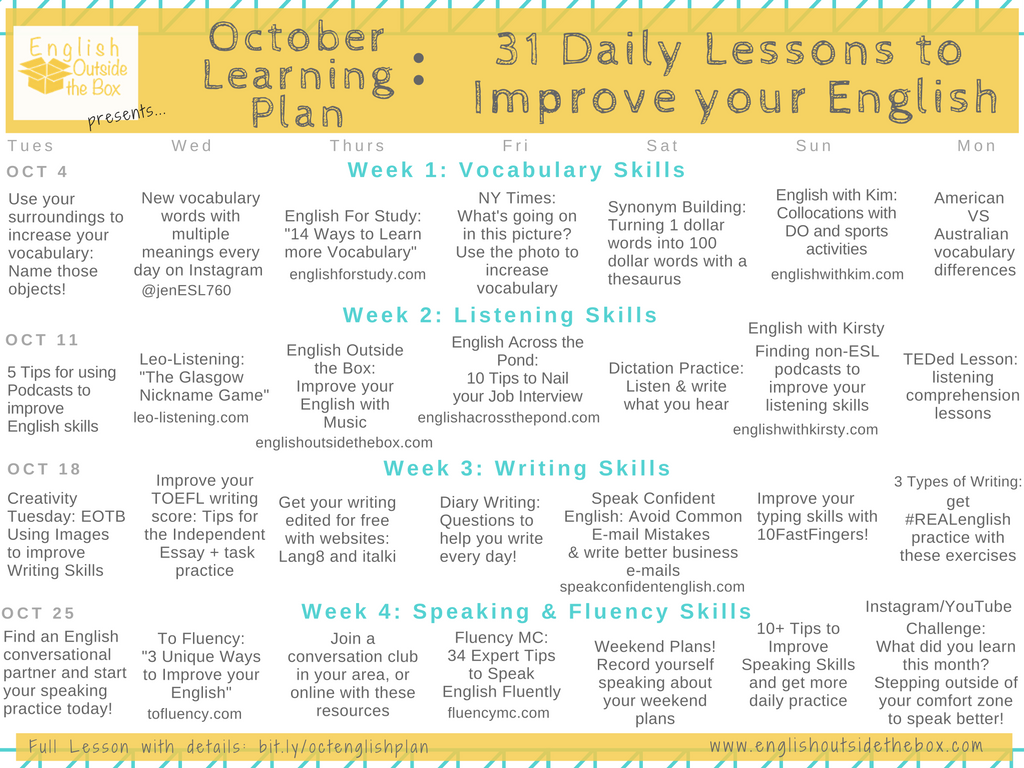
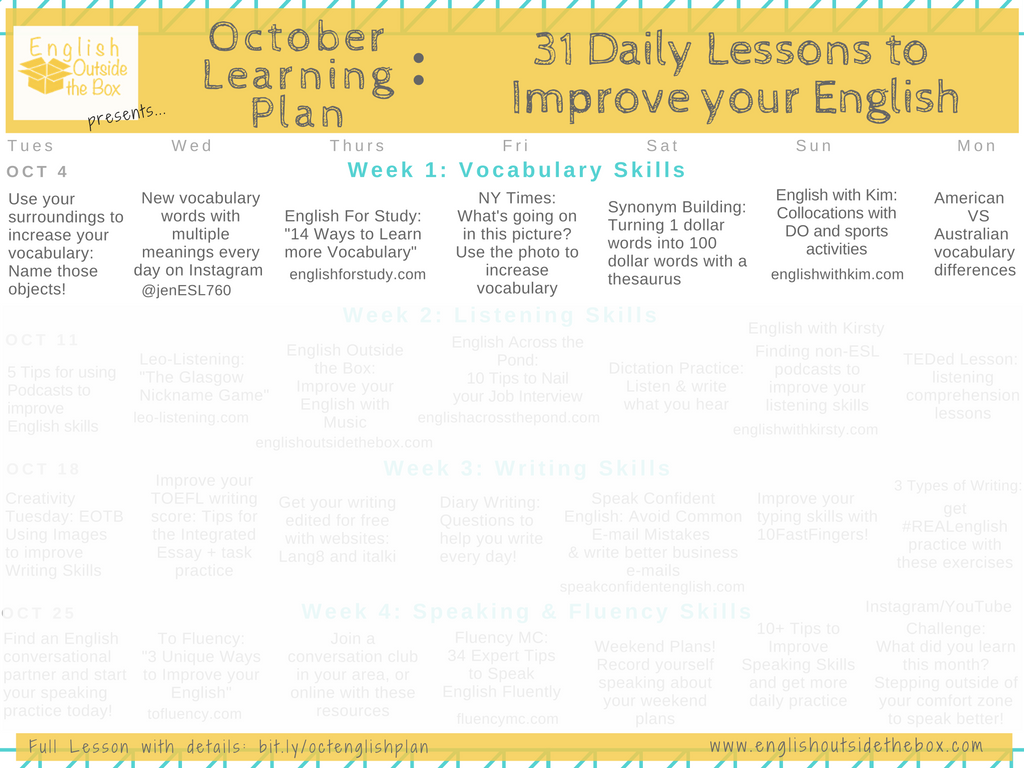
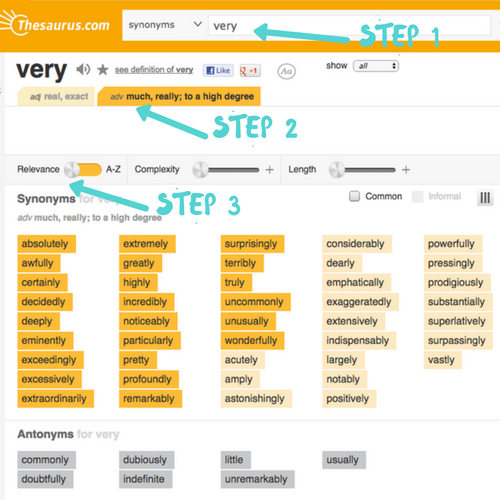
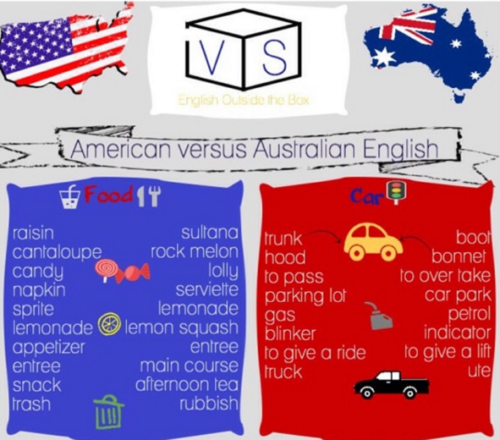
[…] Vocabulary: week 1 […]
[…] Click for week 1 (vocabulary) […]
[…] to access week 1 and improve your vocabulary, you can click on the full curriculum image below or here to get the full English lesson for week 1: […]
This is such a great idea and plan Jennifer! I’m excited to share these posts over the next several weeks with my students. Well done getting this all together! – Annemarie
Thanks so much! I hope your students find them very helpful!
Great work in getting all of this ready, Jennifer! I’ll be sharing this far and wide tomorrow!